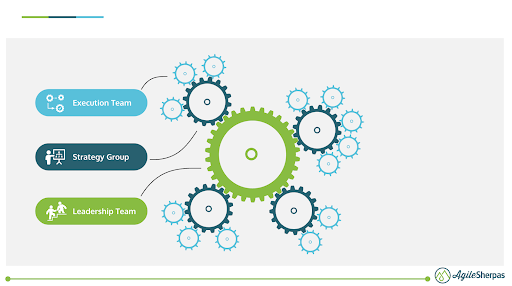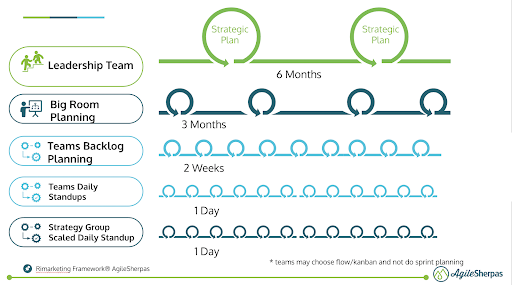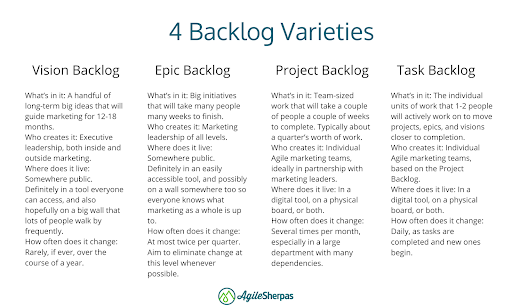Any Agile coach will tell you that one of the most frequently asked questions they get is whether Agile was meant to be applied to strategy OR execution?
With so much content out there about how Agile ways of working are used on the team level, it can be easy to get mixed up. It’s true that many of the practices from Agile frameworks are geared towards what the team does on a daily basis. It’s why many new Agile converts believe agility is just for executing work. Yet, when it comes to true agility, changes in mindset and behaviors are called for at all levels of the hierarchy.
So, the short answer to this question is actually – both. Without the Agile mindset and practices operating at all areas of the planning and execution process, organizations cannot reasonably expect to reap the most sought-after benefits of agility like better prioritization, adaptability to change, or higher team morale.
However, as with any far-reaching transformational change, there’s more to unpack about why applying Agile to strategy and execution at the same time is essential and, unfortunately, easier said than done.
Everybody Makes a Change
When it comes to overarching changes on the team level, team members are expected to be proactive in the way they approach their work and the process they use to complete it. Instead of individual contributors operating as such, there’s a strong emphasis on the team as a unit that they need to respect. By being team-oriented, individual team members are better able to self-organize as a collective and distribute the work items amongst themselves in the best way possible.
Structurally, Agile teams are made up of cross-functional team members who are also able to understand and contribute to a variety of activities in support of each other. As a unit, the teams are made up of individuals with deep expertise in different areas. These types of teams are referred to as cross-functional teams.
On the leadership side, there is a similar metamorphosis taking place. Leaders are also focused on the team as a unit and measure success on the team level instead of evaluating individual performance. It is leadership’s responsibility to present the strategic direction to the team while empowering them to make decisions about how to approach the day-to-day work as a group. In effect, leadership owns the “what” when it comes to strategy, while the team owns the “how” when it comes to execution. Agile leaders rarely, if ever, bypass their teams’ systems of prioritization at the risk of derailing their progress.
These changes on team and leader level are complementary to each other and allow these groups to work better together.

The Organization as Organism
To facilitate this change in mindset and prepare to rapidly respond to changes in the environment, Agile organizations are not structured based on a hierarchy, but rather on a living organism. In an Agile system, execution teams, strategy groups and the leadership team are working together towards common goals and continually influencing each other throughout the process of development.

If the leadership team represented by the green cog in the image above was not working in an Agile way they would be missing out on the many benefits to be had from operating in the same interconnected system of delivery with their counterparts in the execution cogs.
An Iterative Process on All Levels
In Agile organizations, Agile practices are also being leveraged on both strategic and execution levels, especially when work is being planned.

During planning moments, like the annual strategic planning as well as the big room planning, leadership plays a big role in setting expectations about how strategic goals will be measured.
In this way, leaders enable strategic goals to be iterative and influenced by customer-feedback collected through the deliverables produced by the execution teams. Feedback loops like the sprint or daily standups on the execution level are mirrored on the strategic level on a quarterly or semi-annual basis on the strategic level.
Despite the fact that feedback loops are revisited less frequently, data from the execution levels is continually influencing how strategy will evolve when a big room planning meeting or leadership check-in rolls around.
Before proceeding to learn how to translate strategy into execution, why don't you take a second to get our Agile Marketing Transformation Checklist?
From Annual Strategy to Daily Tasks
In fact, the steel thread between strategy and execution is so crucial in streamlining the process between these groups that nearly all daily tasks on the execution level will likely be derived from strategic initiatives.

The role of the strategy groups, made up of marketing owners, other team leaders, or strategists, is crucial in making this work breakdown structure work smoothly.
Marketing Owners and other members of the strategy groups in a given organization are responsible for working with leadership to translate more abstract annual strategies into quarterly goals and then even more actionable monthly projects for the teams. All levels of strategic planning, from leadership team to execution team, make use of the concept of the Agile backlog to document their future activities.
The leadership team backlog contains vision or epic level activities while execution team backlogs are on the project or task levels.
This approach is a winning one for both sides. From the execution team’s perspective, they are able to stay aligned with what the business and their customers need at any given point in time. From the leadership team’s perspective, they have a direct connection to their end customers through the channel of feedback via the execution teams created by this breakdown.
Two Sides of the Same Agile Coin
In truly Agile organizations, the values, principles, and practices that govern the teams on the execution levels also extend to the wider leadership team that is responsible for strategy.
On the path towards ultimate agility on the org level, syncing up an Agile strategy with Agile execution process can be challenging. The stakes of developing an iterative approach to a marketing project are lower if it fails than if a whole strategic goal shifts based on feedback. Iterating on strategy has far-reaching ripple effects that could transform budgets, team structures, resource allocation, and affect large numbers of stakeholders and customers in the process. This can often make leaders and strategists that work alongside Agile execution teams hesitate to apply the same principles to their strategic activities.
That is why getting comfortable with iterating strategically can take a bit more time. Ramping up an Agile team can take 6-12 months if the team is receptive and gels well. Developing an Agile strategic team can take significantly more time and effort.
But, once you’ve got leaders and teams speaking the same language, subscribing to the same system of values, and making the same calculated improvements in their approach based on customer input, the rewards can be truly unprecedented.
Wondering how ready you are for an Agile transformation? Find out with our special checklist: